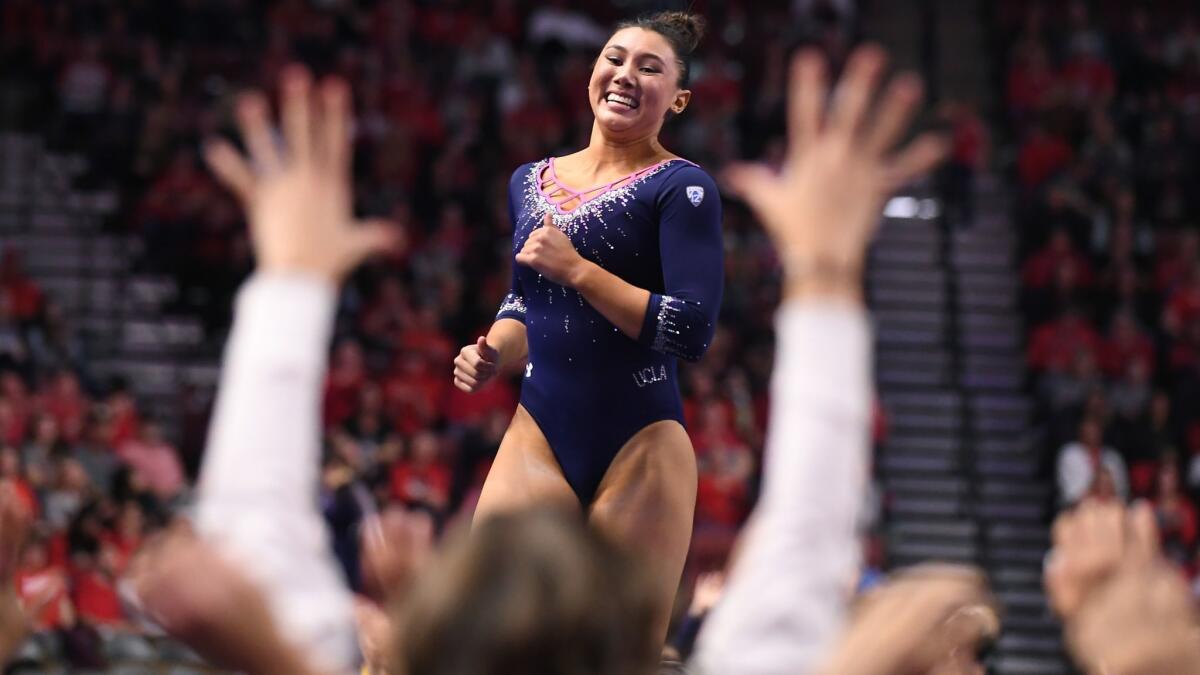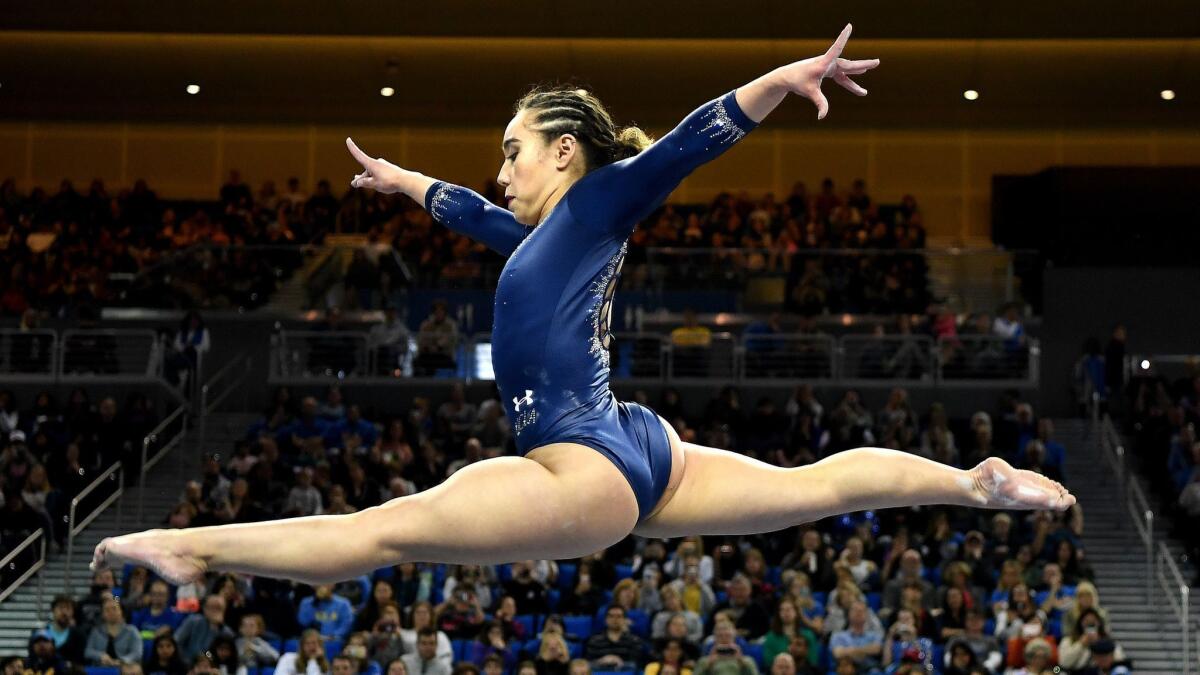UCLA’s 18 perfect scores brings ‘wow’ factor to gymnastics — and some scrutiny

The perfect 10 is supposed to be rare. And for almost every college gymnastics team in the nation it is. UCLA is the exception. In every meet except their season opener, the Bruins have been awarded at least one perfect score.
They have earned 18 perfect 10s, more than every other team in the nation combined.
The feet thudding in flawless landings, hands flashing 10s and crowds erupting have become almost expected.
“It’s not easy to get perfect 10s at all,” UCLA volunteer assistant coach Jordyn Wieber said. “It takes a lot of consistent, hard work and intensity in the gym.”
Katelyn Ohashi has earned six 10s on the floor exercise. Kyla Ross has earned 11, including a “Gym Slam” — a 10 in each rotation, the floor, uneven bars, vault and beam. Madison Kocian has the other 10 — earned on the bars — for the Bruins, who will compete in the NCAA Regionals in Ann Arbor, Mich., on Friday. The No. 2-ranked Bruins, whose only loss came at No. 1 Oklahoma, are expected to qualify for the NCAA championships, which will be held April 19-20 in Fort Worth.
The high scores are partly the product of the exceptional talent UCLA’s gymnasts possess. Ross is a former seven-year national team member who won a team gold medal in the 2012 Olympics; Kocian earned an Olympic team gold and an individual silver medal on bars in 2016. Ohashi defeated Simone Biles, the 2016 Olympic all-around champion, in the 2013 American Cup.
Like judging in diving and figure skating, judging in gymnastics is subjective. While there are scoring standards, even judges can be affected by outside influences. As such, NCAA judges were warned about this in an email sent Feb. 22.
First reported by Lauren Hopkins, a gymnastics journalist, the email was sent from the same no-reply address that notifies judges of their schedules during gymnastics season. Its author was unnamed.
“It has come to our attention that name recognition, team rankings, or media exposure may be affecting scores given by some judges,” the email said. “This could result in some athletes being overscored or underscored due to reputational bias.”
The email reminded the judges that televised meets and social media make their scores subject to wider scrutiny.
“Make sure that your scores are justifiable when reviewed by knowledgeable professionals,” the email instructed.
For most of the 10s awarded in college, Hopkins said, video replays reveal overlooked deductions — an unpointed toe, a slightly arched back, knees spread slightly too far before a landing. The “out-of-control” 10-giving is a regular conversation among gymnastics fans, Hopkins said.
Sign up for our daily sports newsletter »
“I feel like it’s every year,” said one new collegiate judge, who requested anonymity because of the topic’s sensitivity.. “But the only place where I feel it’s more common this year is at UCLA.”
UCLA has earned 56% of the 32 perfect scores awarded nationally this year. In the previous 25 years, only two teams earned more than half of the nation’s 10s in a season.
One experienced collegiate judge, who also requested anonymity, said this was the first time in her career the National Assn. of Collegiate Judges addressed bias in an email. The reminder normally comes from a meet referee, instructing the judges to remain impartial before each competition.
“I think it was because Katelyn Ohashi’s routine had gone viral again,” the newer judge said of the email. “I think the reason why the email went out was because so many people were complaining online.”
Ohashi’s renown has exploded beyond the gymnastics world, her routine the most-watched sports video this year. Like the viral gymnasts who came before her, she has drawn a crowd at every meet she’s competed in. Fans come for her routine and erupt at its conclusion, with raucous cheers and a standing ovation.
Said Hopkins: “How can the judges not respond to that?”
At high-ranked schools like UCLA, the crowds at meets are larger. The competitions are televised on ESPN, the Pac-12 or SEC Networks, and growing fan bases watch.

The margin of victory in college can be minuscule, especially between top-ranked teams. UCLA won the national championship last April by .0375 of a point, a figure smaller than the smallest possible deduction in college gymnastics, .05. One score can determine the meet’s outcome, or whether a gymnast qualifies for postseason meets. The pressure on judges is high.
“You just want to make sure that when you put up your score,” the veteran judge said, “you can verify it.”
Sometimes, the newer judge said, the crowd will boo in response to a score. Coaches sometimes shout in protest, roll their eyes or argue with the meet referee. Hopkins said she has seen coaches confront judges, even though that is against the rules.
A school’s reputation can sway a judge as well. Top-ranked teams like UCLA are expected to earn 10s, while smaller programs don’t receive the same assumption, the newer judge said. For a gymnast like Ross, Hopkins noted, her reputation could afford her the benefit of the doubt.
“I strongly believe our officials go in with an open mind and judge what they see, for the most part, that night,” the veteran judge said. “I do believe some kind of get caught up with the moment, caught up with the gymnast, and are generous with their score.”
It helps Ohashi’s case that she is the only college gymnast to execute a split double layout in her floor routine. Unlike elite gymnastics, college gymnasts receive no formal benefit for having difficult routines. But, as Wieber noted, that doesn’t mean there isn’t one.
“It definitely adds a ‘wow’ factor, which I feel like gives you a little bit of an advantage with the judges,” said Wieber, who was part of the 2012 Olympic gold-medal team. “You take the risk and do harder skills … they’re more likely to give you the benefit of the doubt.”
Before the email was sent, UCLA averaged 1.33 perfect scores per meet. Since, the Bruins have averaged two 10s per competition. The newer judge pointed out that there is more to a result than raw numbers; the judges are ranking routines, not just scoring them.
“As long as the best girl wins, as long as the best team wins, at the end of the day, that’s all that matters,” the newer judge said. “So are the 10s a little ridiculous? Yes. But is UCLA the best team?
“Probably.”
More to Read
Go beyond the scoreboard
Get the latest on L.A.'s teams in the daily Sports Report newsletter.
You may occasionally receive promotional content from the Los Angeles Times.










